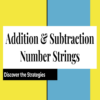Math Diagnostic Interview: Early Detection & Targeted Intervention
$24.00
Do you have students who have math gaps, and you need to figure out what those gaps are? Once students are identified by your Universal Screener, this Diagnostic Interview can be used to determine deficits and target instruction based on need.
This math diagnostic interview was created by educators dedicated to identifying students’ strengths and weaknesses in their mathematical understanding!
| Subject | Grade Levels | Resource Type | File Type |
| Math, Assessment, |
ALL |
Diagnostic Assessment | PDF, 37 pages |
Description
To really know your students, a math diagnostic interview can be an important way to know your students’ understanding in multiple domains. The information that this diagnostic will give you about your students’ math knowledge and number sense is amazing. This diagnostic tool allows you to dig deep about your students’ knowledge, make plans for whole-group and small-group instruction and show progress for students who are not at grade-level standards.
Included in this Resource:
- 37 pages
- Assessment Recording Forms
- Knowledge of Word Problems Structures assessment
- Math glossary
- Templates for questions are included
- What to look for as you watch your students answer the questions
The math diagnostic interview was created by educators dedicated to identifying students’ strengths and weaknesses in their mathematical understanding. The interview is not a universal screener to be administered to all students. However, it is intended to serve as a 1:1 diagnostic interview with students to learn more about their level of understanding in foundational skills that are critical for conceptual understanding of mathematics. A research based universal screener should be used to first identify students who are at risk for difficulties in mathematics. Once students are identified, the Diagnostic Interview can be used to determine deficits and target instruction based on need.
The interview is designed for educators to observe (hear and see) students’ strategic approach to solving math. The assessor should write observations that would be helpful as targeted instruction is designed to close students’ gaps.
The Diagnostic Interview is not intended to be used for progress monitoring, but it can be re-administered up to three times per year (BOY, MOY, and EOY) to measure whether or not the student is closing foundational gaps. It is recommended that you align more frequent progress monitoring to the intervention being provided between growth checks using this assessment.



























Reviews
There are no reviews yet.